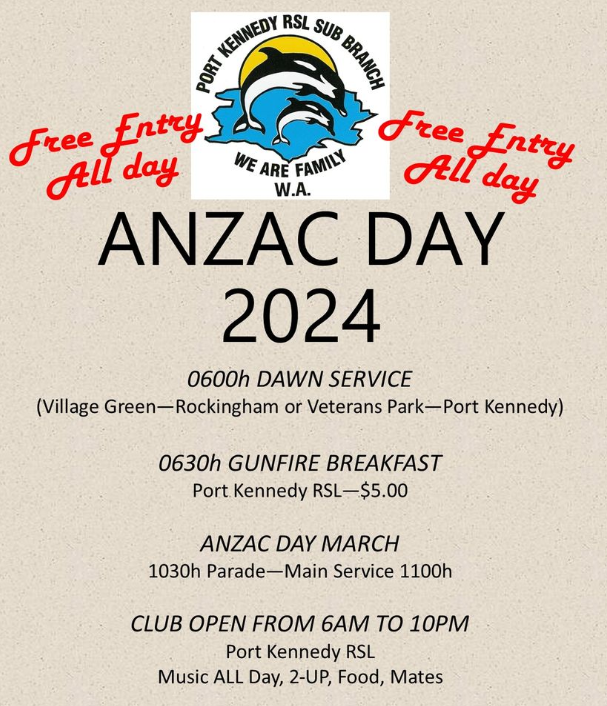
ANZAC Day update. Some more detailed information has come to hand.
DAWN SERVICES:
KWINANA: at 5.50 at Kwinana War Memorial, Pace Road Medina, followed by breakfast hosted by Kwinana Knights football club.
ROCKINGHAM: Rockingham VIllage Green at 5.30, followed by Rotary Club sausage sizzle, gold coin donation at PCYC, (Police and Citizens Youth Club) in Emma Street.
PORT KENNEDY Veterans' Memorial Park at 6am followed by Gunfire Breakfast from 6.30, $5.
NAVY CLUB have breakfast at 8 with a bus to the 10.20 service at Rockingham.
SECOND SERVICE AND MARCHES:
Marches and Services at 10.20 (Rockingham) or 10.30 (I think) Kwinana and Port Kennedy.
Rockingham RSL have a ticketed event including refreshments $20 members, $30 non-members
Port Kennedy RSL have free entry open to all, all day, with entertainment 10 to 3 and again from 4.30
to 8.30 and 2-UP from noon to 4.30
The Kwinana Local has Twice as Nice playing from 7pm and other venues may have entertainment I don't know about.

Here is an ANZAC DAY song, a music video from Jarick of HMAS Stalwart, an entry in the Rockingham Song Contest 2024.
It is called
'Bleed for you'.
Each year, I attempt to learn more about what happened and why, before saying LEST WE FORGET.
This year I learned that the very first ANZAC Day Remembrance was held in Westminster Abbey in 1916,
where it has been held annually ever since.
In Australia, some state governments organised events to commemorate the occasion, but the Commonwealth, other than naming the day as Anzac Day, did not. By the late 1920s, Anzac Day was a public holiday in every state and territory.
This year I have learned more about the war correspondent Keith Murdoch and his role in WW1.
In September 1914 Charles Bean, defeated Murdoch in a ballot by their journalist peers for
the position of Australia’s official war correspondent.'
As a journalist who spent a few days at Gallipolli, Keith Murdoch wrote the 'Gallipolli Letter', a scathing attack on events there. Murdoch's conversational yet brutally honest letter played a key role in ending the Gallipoli campaign and in the evacuation of British and ANZAC troops from the peninsula.
'The Gallipoli letter is an 8000-word private report written by journalist Keith Arthur
Murdoch (1885–1952), with the help of British war correspondent Ellis Ashmead-Bartlett
(1881–1931), after visiting the Gallipoli peninsula in September 1915.
It describes the
organisation and conditions of the Gallipoli campaign. It was sent to Andrew Fisher (then
prime minister of Australia) and Henry Herbert Asquith (then prime minister of the United
Kingdom). Murdoch’s 28-page letter helped to establish the idea of Gallipoli as a military
disaster.
Fisher sent Murdoch to Gallipoli for an honest report on the campaign. Contrary to the
rules of censorship, Murdoch wrote and sent his letter without submitting it to the military
censors. In the eyes of some, this was a grave betrayal of Murdoch’s role at Gallipoli.
Murdoch, however, strongly defended his action on the grounds that his letter was not for
publication but for the information of the prime minister.
Whether or not Murdoch did the right thing in sending the letter uncensored, it had a
serious impact and brought about rapid results. It can be argued that Murdoch’s letter led
directly to the ending of the Gallipoli campaign, and the evacuation of British and Anzac
troops from the peninsula.'
Between 8 and 20
December 1915, about 90,000 allied soldiers were secretly withdrawn from Gallipoli.
There were very few casualties.
Following the success of the Gallipolli Letter, Keith Murdoch and Andrew Fisher (by then Australian High Commissioner in the United Kingdom, having been replaced by Billy Hughes as Prime Minister), instigated the first ANZAC Day service at Westminster Abbey in 2016, attended by attended by the King, the Queen and Lord Kitchener, amongst other pillars of the military and political establishments.
'On 25th April 1916, around 2,000 Australian and New Zealand soldiers marched through the streets of London to the Abbey where a special service was held in the presence of King George V and Queen Mary to mark the first anniversary of the Gallipoli landings.
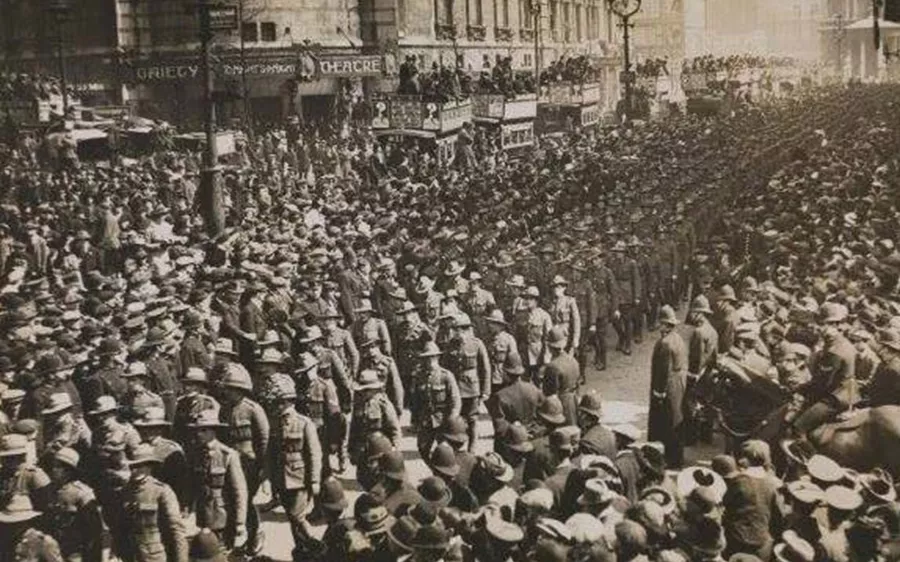
The photo below is of me wearing my Port Kennedy RSL 2018 ANZAC Day shirt, with my wife Merilou at the Australian War Memorial at Villers-Bretonneux, a very emotional experience.
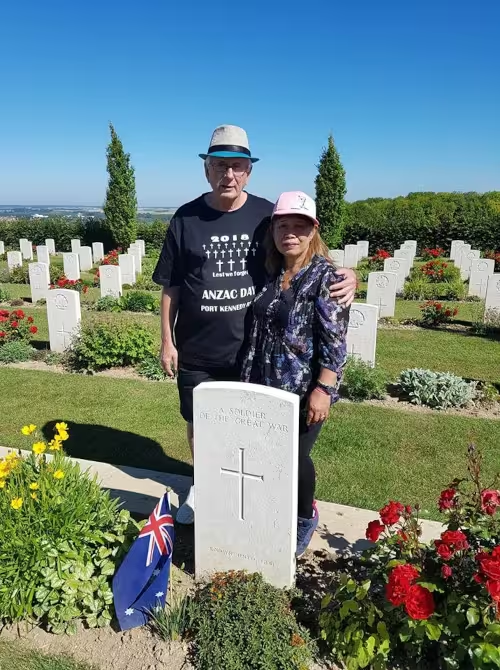
It was the Centenary year of the Battle of Villers-Bretonneux fought on ANZAC Day, 1918.
To learn more about what happened, we have made 3 trips, two to the Western Front, and one to Sandakan in Borneo.
One year, we stayed in Bruges in Belgium and took a day tour to pay our respects at the Australian Cemeteries in the area,
such as the Tyne Cot cemetery.
For a list of cemeteries, please visit the Sir John Monash Centre website.
The day trip took us to Ypres or Iepers, where the Last Post is performed daily at the Menin Gate Memorial by
the Last Post Association. There are videos of the daily ceremony on the Last Post website.
We learned about Hellfire corner. Hellfire Corner was an important transport hub on the Menin Road,
which ran from Ypres to the frontline trenches.
At Hellfire Corner, German machine guns and artillery were trained on allies wanting to move from Ypres to the trenches in the frontline.
Many thousands of lives were lost at Hellfire Corner.
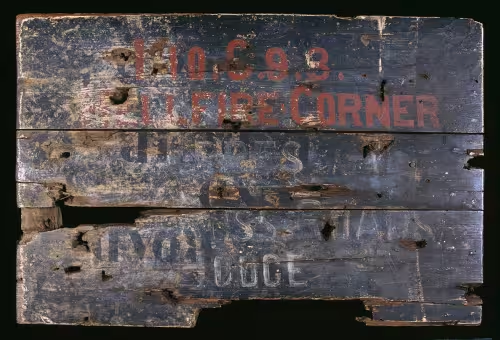
On the day tour, we learned about the 'Iron Harvest'.
Over 100 years later, huge amounts of Unexploded Ordnance (UXO) are still being found. Found mainly at spring plantings and autumn ploughings.
From wikipedia: 'During World War I, an estimated one tonne of explosives was fired for every square metre of territory on the Western front. As many as one in every four shells fired did not detonate. In the Ypres Salient, an estimated 300 million projectiles that the British and the German forces fired at each other during World War I were duds, and most of them have not been recovered. According to its website, DOVO,
the demining unit of the Belgian armed forces, defused more than 200 tons of ammunition in 2019.
In Belgium, munitions and wartime iron harvested by farmers are carefully placed around field edges or in gaps in telegraph poles, where they are regularly collected by the Belgian army for disposal by controlled explosion at a specialist center in Poelkapelle.
The depot was built after ocean dumping of shells stopped in 1980.
Despite their age, unexploded munitions remain very dangerous. The French Département du Déminage (Department of Mine Clearance)
recovers about 900 tons of unexploded munitions every year.
Since 1946, approximately 630 French ordnance disposal workers
have died handling unexploded munitions.
Over 20 members of Belgian Explosive Ordnance Disposal (DOVO) have died disposing of First World War munitions
since the unit was formed in 1919.
In just the area around Ypres, 260 people have been killed and 535 have been
injured by unexploded munitions since the end of the First World War. Shells containing poisonous gas remain viable and will corrode and release their gas content.[8] Close to five percent of the shells fired during the First World War contained poisonous gas,
and ordnance disposal experts continue to suffer burns from mustard gas shells that were split open.'
In 2018, we visited the Australian War Memorial at Villers-Bretonneux, home of the Sir John Monash Centre.
We have visited Sandakan to pay repects to the thousands of prisoners who died in the prisoner of war camp there.
I think people migrating to Australia should know more about Australia's
role in defending democracy and freedom and the supreme sacrifices made, and the hugely important role it has played, not only in WW1 but other wars.
Many new Australians probably consider Anzac Day as just a day off. I feel it incumbent on me to try and change that!
Coincidence had our visit during the centenary year of the second battle of Villers-Bretonneux ( fought on Anzac Day, 1918) and the battle of Le Hamel, July 4th, 1918. I am certain the Australian troops, who fought like hell to push the Germans back, and retake Villers-Bretonneux,
had the date, April 25, three years after the battle of Gallipolli, at the back of their minds as a great motivator.
I hope Australia's contributions to the Western Front are mentioned at the ANZAC Day services this year.
At the battle of Villers-Bretonneux, fought on ANZAC Day 1918, Australia made up a large component of the forces that stopped the Spring Offensive as Germany aimed for the railhead at Amiens. On April 24, using mustard gas and 13 tanks, (the first time tanks were used in battle), the Germans took Villers-Bretonneux. The Battle of Villers-Bretonneux on ANZAC Day, 1918, saw the village retaken and the German advance to Amiens (the railhead) was halted. It was a major step in halting the Spring Offensive.
The allies had just 3 British tanks, but 2 were "female" armed only with machine guns, at a disadvantage to the German tanks.
The Allied counter attack was led by the Australian 13th and 15th Brigades under Brigadier-General Thomas William Glasgow
and H.E. “Pompey” Elliot respectively with support from troops from other nations.
In July 1918, John Monash, whose father was a German immigrant who changed his name from Monasch,
completely changed the face of the war from futile trench warfare to total warfare.
At the battle of Le Hamel, Monash planned the battle to last 90 minutes. It took 93. It involved long range artillery and air attacks, followed by tanks and the infantry only went in last to mop up. The nature of war changed forever due to the strategy of John Monash.
The Battle of Le Hamel was the first time US troops served under non-American command. 1,000 men from the American Expeditionary Force fought alongside the Australian Corps during the Battle of Le Hamel on 4 July 1918 with John Monash as leader.
The Australian historian, Charles Bean, together with the war journalist, Keith Murdoch and William Dyson,
had tried to prevent John Monash from being appointed leader of the AIF.
Monash was the preferred choice of the departing British leader, Field Marshall William Birdwood. The meddling trio wanted Major General Brudenell White, despite White never having commanded a force in the field.
II previously thought it was due to his German origins.
This year I discovered that was not the case. Charles Bean was racist and anti-semitic, and Dyson was also anti-semitic, and attempted to prevent John Monash from becoming leader of the AIF (Australian Imperial Force)
because he was Jewish.
The Australian PM at the time, Billy Hughes went to the Western Front with the intention of appointing Cyril White, not John Monash, as commander of the AIF, Australian Imperial Force.
Incredible that a historian could have been involved with attempting to change the course of history.
Fortunately, there were enough sane heads who all approved of Sir John Monash and his plans, and Billy Hughes went home.
Keith Murdoch’s final intervention in the Great War was a questionable exercise in string pulling as he, Bean, and war artist William Dyson (1880-1938) sought to prevent Lieutenant General John Monash (1865-1931) from succeeding General Sir William Birdwood (1865-1951) as Commander of the Australian Corps. Birdwood assumed the command of the British Fifth Army and recommended in May 1918 that Monash take over the Australians. Murdoch and his allies campaigned hard that this prize should instead go to Major General Brudenell White (1876-1940), despite White never having commanded a force in the field. Bean and Dyson were in part motivated by anti-Semitism (Monash was Jewish); Murdoch’s motives are unclear. The troika’s efforts were unsuccessful, and Birdwood remained firm. Keith Murdoch’s biographers have been silent on this matter. Military and media historians, however, have been scathing in their condemnation of this interference in army affairs.
This from the National Film and Sound Archive of Australia website:
'This makes clear that Bean, at least, already knew that most of the senior Australian staff did not support his view that White, rather than Monash, should be Corps commander. At the beginning of his campaign against Monash six weeks earlier, he was convinced that the opposite was true. Everyone, he told himself, believed that White was the better man. He had had time in those six weeks to hear the views of the various commanders,
some of whom attacked him directly for his meddling. It’s also clear in his diary entry that he still had hope –
mainly that the persuasive Keith Murdoch, a war journalist (and father of Rupert Murdoch) would hold Hughes to their line.
They failed, and Monash became one of the most influential and lauded commanders
on the British side in the final months of the war.'
Had Bean been successful in preventing John Monash from becoming leader, the outcome of The Great War may well have been different. The German Spring Offensive was in full swing in 2018.
The battle of Le Hamel was duly fought and won, with John Monash in charge, in 93 minutes, and from then on the German forces went into retreat. And the nature of war changed forever.
Charles Bean later had the Federal seat of Bean in the ACT named after him, first contested in 2019. From the Australian Election Commission website: the seat was named after Bean as 'Australia's official correspondent to the Australian Imperial Force in World War One, editor of the Official History of Australia in the War of 1914–1918 and primary advocate to establish the Australian War Memorial.' There were 55 objections. This from the Australian government in 2018:
'The redistribution received more than 55 objections to the name Bean.
The Commission noted that the reasons included Charles Bean being inappropriate for having a division named after
him due to views he expressed about Sir John Monash,
and that the name was ‘most associated with the character Mr Bean and such an association would make the electoral division and the member the subject of jokes’.
The Commission noted that it ‘considers Australia a sufficiently mature and open-minded society’ not to reject a name
due to sharing a name with a ‘comedic character’.
The Commission stated that it considered the totality of Bean’s life and voted 4 to 2 in favour of retaining the proposed name Bean.'
The seat of Monash in Victoria was created at the same time. This also from the Australian Electoral Commission:
'Named in honour of Sir John Monash CB(M) KCB(M) GCMG, 1865–1931. Monash was one of the foremost Allied military commanders of the First World War and was recognised for his outstanding contributions to the community. '
So there you go!
Did you know that for the comprehensive victory at Le Hamel, John Monash was made a Knight Commander of the Order of the Bath by King George V on 12 August 1918, at Château de Bertangles. This was the first time in 200 years that a British monarch had knighted a commander on the battlefield? I think Australia should change his name back to Monasch and change the University's name! A quote from John Monash: "Equip yourself for life, not solely for your own benefit but for the benefit of the whole community". John Monash was a successful engineer who applied engineering principles to the battlefield. He built bridges and railways in Melbourne. But I doubt if his name resonates outside Australia, which is sad because he was one the true heroes of WW1. He had been in the Army Reserve for years before the outbreak of WW1.
ANZAC day focuses on the tragic events of Gallipolli.
Gallipoli was a folly of Winston Churchill among others.
At least Churchill learnt from this mistake as a strategist in the role he played in WW2, but at the cost of thousands of ANZAC lives.
In Gallipolli, 8,141 Australian lives were lost in a senseless attack which had no influence on the outcome of the war.
More than 295,000 Australians served on the Western Front.
Some 46,000 were killed in action or died from other causes.
More than 100,000 were wounded. This was a much bigger loss of life than Gallipolli.
But have their efforts on the Western Front been recognised enough?
How many Australians travel to Villers-Bretonneux on ANZAC Day compared to Gallipolli?
At the battle of Villers-Bretonneux on Anzac Day 1918, it was Harold "Pompey" Elliot and William Glasgow who
led the counter attack to retake the village.
Not Monash! Malcolm Turnbull, as Australian PM made a terrible gaffe, which made me wince, when he attended the dawn service at Villers-Bretonneux, mistakenly stating that Monash was in charge at the Battle of Villers-Bretonneux. How could his minders and speech writers allow him to get it so wrong? I wonder what the French thought of his faux pas.
I wish those that run the dawn services would use them to spend more time to focus on Australia's enormous loss of life on the Western Front, the conditions they faced living in trenches, being bombed with mustard gas and so on, and on the prominent role Australia played in turning back the Spring Offensive at these two battles, after which the result of the war became inevitable.
And in World War 2, of 21,467 Australian prisoners taken by the Japanese, only 14,000 survived.
Many died building the Thai Burma railway.
After the fall of Singapore, around 2,000 Australians and 500 British soldiers were taken to Sandakan in Borneo to build a military airfield for the Japanese. Sandakan is infamous for its Death Marches. The only six who survived were those who escaped, otherwise the atrocities of Sandakan would never have been known as the prison camp was burned down to destroy the evidence. Here is song about Sandakan by Russell Morris, whose father was one of the survivors.
Here is a song by Russell Morris, a son of one of
the half dozen survivors from the Sandakan prison camp
And here is an article about Billy Young,
one of the escapees, and the painting below of the 'Flying practice' torture at the Sandakan prison camp
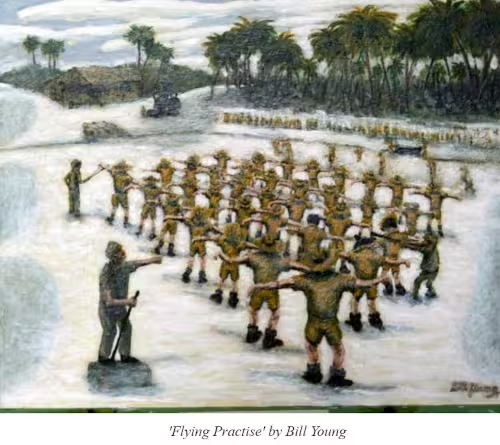
And here is an introduction to Billy Young's book
Before we say, "Lest We Forget", I think it is time to think a little more about what it is we should be remembering!
And here is a question for you. Why is a poppy used as an emblem for Remembrance Days in Australia and the UK?
We have been fortunate enough to visit Sandakan to pay our respects. We have been fortunate enough to pay our respects at the Australian War Memorial in Villers-Bretonneux and to travel around key areas of the Western Front, including Hell's Gate, Ypres, and Hill 60. Around Hill 60, tunnels were dug under enemy lines, then packed with explosives. "7 June 1917, British forces simultaneously blew up 19 mines as the opening move in the Messines attack. The Hill 60 mine created a crater 60 feet (18 m) deep and 260 feet (79 m) wide. The German front-line troops were overwhelmed." What that quote omits to say (and so much of British war history omits the assistance of Australia and other allies!) is that the 1st Australian Tunnelling Company' were involved in digging the tunnels. The term "Digger" was not just from the gold rush, but from being good at digging trenches and tunnels in Gallipolli and the Western Front. The explosion was like an earthquake and was felt as far away as London. With 90,000 pounds of explosives, it was the biggest man made explosion ever. They had to rely on and thank the miners of Australia to do the tunnelling! The record for an explosion stood until Hiroshima in World War 2
Here is a link to a trailer for the movie Beneath Hill 60, made in 2010. Check it out! It is the true story of Oliver Woodward. Costs $3 or $4 to view the movie. Cheap for an important history lesson!
And let us not forget those who fought and died in more recent wars, such as in Vietnam, Iraq and Afghanistan, veterans who still live with PTSD and ADF Personnel who are currently serving and protecting our freedom and democracy or have left the forces. When you leave the ADF, a great deal of connection is lost.
I am thankful for being part of a rare generation that has not experienced war on home soil.
That we live in a democracy and have freedom is entirely due to the sacrifices of those who went before and those who currently serve.
But don't take freedom for granted. Freedom needs to be defended in times of peace, and exercised wisely.
On a personal note, this year I will also be reflecting on the war correspondents in all wars. They have enormous responsibility.
I am reflecting on the incredibly brave people from Australia and around the world who
are journalists or humanitarian aid workers in Gaza. According to the Committee for the Protection of Journalists, already 97 journalists have been killed in Gaza.
Over 200 aid workers have been killed. My thoughts are with those families who
have lost loved ones who were simply trying to help get food and medical supplies to over 2
million starving people under siege and bombardment, and to the journalists and aid workers who continue their work,
and to their anxious families and friends.